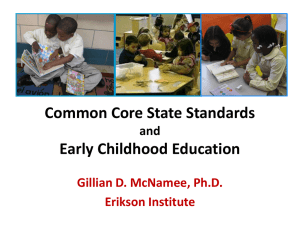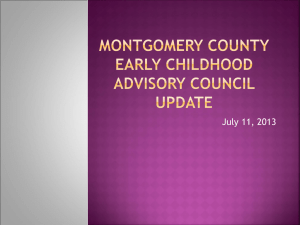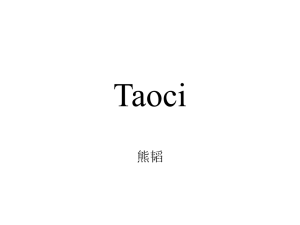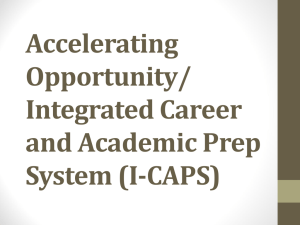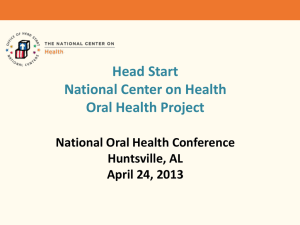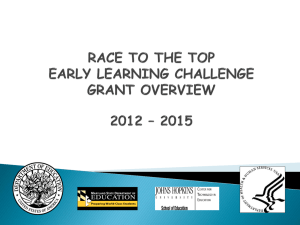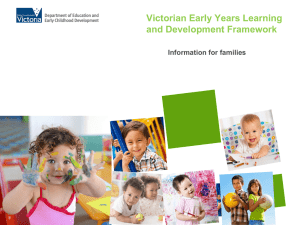Play and Learning - Encyclopedia on Early Childhood Development
advertisement
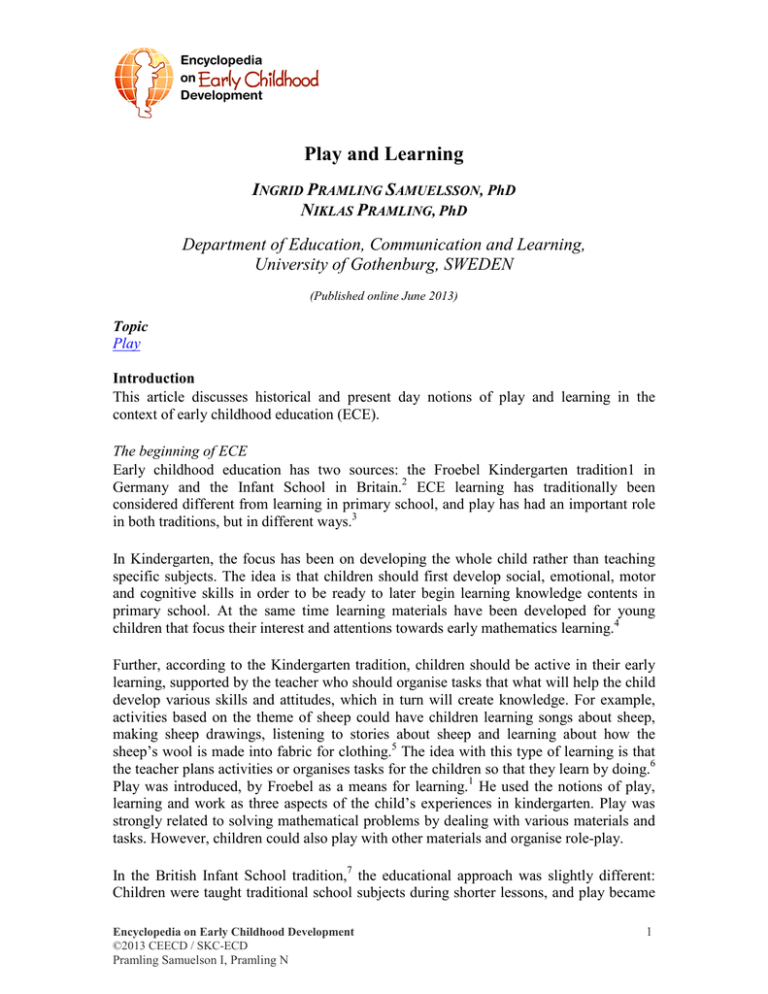
Play and Learning INGRID PRAMLING SAMUELSSON, PhD NIKLAS PRAMLING, PhD Department of Education, Communication and Learning, University of Gothenburg, SWEDEN (Published online June 2013) Topic Play Introduction This article discusses historical and present day notions of play and learning in the context of early childhood education (ECE). The beginning of ECE Early childhood education has two sources: the Froebel Kindergarten tradition1 in Germany and the Infant School in Britain.2 ECE learning has traditionally been considered different from learning in primary school, and play has had an important role in both traditions, but in different ways.3 In Kindergarten, the focus has been on developing the whole child rather than teaching specific subjects. The idea is that children should first develop social, emotional, motor and cognitive skills in order to be ready to later begin learning knowledge contents in primary school. At the same time learning materials have been developed for young children that focus their interest and attentions towards early mathematics learning.4 Further, according to the Kindergarten tradition, children should be active in their early learning, supported by the teacher who should organise tasks that what will help the child develop various skills and attitudes, which in turn will create knowledge. For example, activities based on the theme of sheep could have children learning songs about sheep, making sheep drawings, listening to stories about sheep and learning about how the sheep’s wool is made into fabric for clothing.5 The idea with this type of learning is that the teacher plans activities or organises tasks for the children so that they learn by doing.6 Play was introduced, by Froebel as a means for learning.1 He used the notions of play, learning and work as three aspects of the child’s experiences in kindergarten. Play was strongly related to solving mathematical problems by dealing with various materials and tasks. However, children could also play with other materials and organise role-play. In the British Infant School tradition,7 the educational approach was slightly different: Children were taught traditional school subjects during shorter lessons, and play became Encyclopedia on Early Childhood Development ©2013 CEECD / SKC-ECD Pramling Samuelson I, Pramling N 1 PLAY a form of relaxation in between the lessons. But here also play was considered important – given that children were not supposed to be able to concentrate other than for a short time – play was a way to recuperate before a new lesson. Play and Learning in the Field of ECE In both the Kindergarten and Infant School traditions, play had and continues to have an important role in young children’s education. Currently, in all ECE frameworks or curricula, play continues to have an aspect of importance.8,9,10,11 However, even though there are many books that discuss play and learning on an academic level,12,13 research seldom studies how play and learning are related, or what function play should have in the ECE system. In practice, it seems it is taken for granted that play is the children’s world and is crucial to their education. Further, the United Nations Convention of the Rights of the Child,14 states that all children have the right to play. On one hand, it is hard not to view play as central to young children’s lives. On the other hand, play is not part of all children’s life, either in their neighborhood or in ECE,15 even if all humans at heart could be argued to be playing individuals, as suggested by Huizinga.16 One can claim that ECE generally involves structured activities, for learning or pleasure, but also less structured activities, often called “free play.” The notion of free play is generally understood as being the opposite of teacher-organized activities. In free play, children lead their activity and use their imagination, as opposed to learning, where specific skills or knowledge are expected to be learned. Montessori17 even talked about not letting young children read stories and fantasies (play with reality) before they first learn about reality. In an international comparison of young children’s experiences in ECE in seven countries, it was obvious that play is central to the lives of all young children.18 Also, in some countries it was not even a question of talking about the youngest children in terms of learning, but that children learn when they play. Participants from most countries expressed the intention of finding a more up-to-date approach to early years education, and play was always considered an important part of the approach. There is also a kind of rhetoric and belief in ECE that play is always positive, which is, actually, not always the case.19 The romantic view of young children’s play is built on the idea that children learn when they play. However in the context of ECE, there are specific skills and knowledge children should be supported in developing and, therefore, activities to some extent have to be goal-directed.20 The Playing-Learning Child In a meta-analysis of praxis-oriented research, Pramling Samuelsson and Asplund Carlsson21 formulated the concept of the playing-learning child. This is a child who does not separate between play and learning, and instead relates to the world around him or her in a playful manner. They create ideas, fantasize and talk about reality simultaneously. For example, when a teacher asks a child to draw a tree they studied during an excursion to the forest, the child may challenge the teacher by adding Winnie-the-Pooh to the drawing of the tree.3 According to many teachers, the child should draw the tree from the forest first – then he could play! Encyclopedia on Early Childhood Development ©2013 CEECD / SKC-ECD Pramling Samuelson I, Pramling N 2 PLAY Children, particularly young children, in ECE have not yet learned to decipher what is to be considered learning and what is to be considered play, but they do allow themselves to be creative if the teacher gives them communicative space.22 This means that the teacher also has to take the child’s approach as a base for arranging a preschool approach built on the playing-learning child. Integrating Play and Learning in Early Years Pedagogy What does the playing-learning child mean in everyday life in ECE? What does it take for a teacher to work according to this theoretical notion of children as playing-learning individuals in ECE? As we can see, it puts demands on the teachers to adopt specific theoretical approaches, that is, theories built on communication and interaction. It also requires the teacher to look at knowledge in terms of the meaning children create, how they make sense of the world around them. Looking at current ECE practices, there are generally three forms of early childhood curricula: the “traditional” social pedagogy based on Froebel, the “academic” pedagogy based on school subjects and skills, and innovations such as “developmental pedagogy” in which play and learning are integrated through an investigative pedagogy. Sylva et al.23 found that differences in pedagogy (linked to curricula) led to wide differences in children’s developmental outcomes. Thus, curriculum and pedagogy make a difference to children’s development as well as contribute to the success and well-being of society. The concept of pedagogy/didactics (from a European perspective) is central in some countries, especially in the Nordic preschools. Based on the German/European idea of “buildung,” curriculum and pedagogy become integrated. Didactics focuses on the ways the teacher “points something out to children,” that is, directing children’s attention towards specific areas of knowledge, skills or attitudes that will enhance their development. Didactics is the crossroad between the learning object (what children should be supported in creating meaning about) and the act of learning (how children play-learn). Shared meaning-making depends on the teacher’s capacity to relate her/himself to the child within the learning situation. This approach is centred on children’s meaning-making.20 This didactic approach is based on “variation as a fundamental aspect of learning,” framing the learning situation, social encounters and coordinating the child’s and the teacher’s perspectives. This means that there will be a space for each child to be involved in learning and to also use play and fantasy to try to make sense of the world around them. It is through communicative didactics that children can begin with a context-bound language and move towards an expansive language and knowledge of what it means to know something deeply, and finally to also become aware of knowledge patterns.24 Research Gaps, Conclusions and Policy Implications By tradition, researchers study play or learning, while there is a need for studies of how play and learning can be integrated in a goal-related practice, but also what it means for the child to be in an ECE where children’s worlds are appreciated and valued. Countries could consider their curriculum in the light of others, and considered how play and learning are talked about and planned for/supported, and see how a new approach could Encyclopedia on Early Childhood Development ©2013 CEECD / SKC-ECD Pramling Samuelson I, Pramling N 3 PLAY build on a more child-centred communicative approach in early years. Since we know today that the early years are fundamental for the child’s future learning, as well as for the development of society,25 every country should review their curriculum and approaches to ECE. REFERENCES 1. 2. 3. 4. 5. 6. 7. 8. 9. 10. 11. 12. 13. 14. 15. 16. 17. Froebel F. Education of man. USA: Authorhouse; 2004, original 1825. Whitbread N. The evolution of the nursery-infant school: A history of infant and nursery education in Britain, 1800-1970. London: Routledge and K. Paul; 1972. Pramling Samuelsson I, Pramling N. Winnie the Pooh sat in a tree, or did he? A contemporary notion of early childhood education beyond teaching and free play. In O. F. Lillemyr, S. Docket & B. Perry, eds. Varied perspectives of play and learning: Theory and research on early years’ education. Greenwich, CT: Information Age. In press. Leeb-Lundberg K. Friedrich Froebel's Mathematics for the kindergarten. Philosophy, program and implementation in the United States. New York: School of Education of New York University; 1972. Doverborg E, Pramling I, Qvarsell B. Inlärning och utveckling. Barnet, förskolan och skolan [Learning and development: The child, preschool and school]. Stockholm: Liber; 1987. Dewey J. Democracy and education: An introduction to the philosophy of education. New York: Free Press; 1916. Owen R. Education in Robert Owen’s new society: The New Lanark institute and schools. Available at : http://www.infed.org/thinkers/et-owen.htm. Accessed June 3, 2013. Oberhuemer P. International perspectives on early childhood education curricula. International Journal of Early Childhood 2005 37(1), 27-37. Skolverket. Curriculum for preschool, 1 to 5 year. (revised 2010). Stockholm: Skolverket; 2010. OECD. Building Strong Foundation. Paris: OECD; 2010. OECD. Starting Strong: Early childhood education and care: Education and skills. Paris: OECD; 2001. Johnson JE, Christie JF, Wardle F. Play, development and early education. New York: Pearson; 2005 Wood E, Broadhead P. Developing a pedagogy of play. London: Sage; 2010. UN. Convention of the Rights of the Child. 1989. Pramling Samuelsson I., Kultti A. Children and their play: Looking at the world’s cultural diversity. Report from the OMEP conference, Campo Grande, Brazil, July 2013. In press. Huizinga J. Homo ludens: A study of the play element in culture. Boston, MA: Beacon Press; 1950 Montessori M. The formation of man. Oxford: Clio; 1989, original 1955. Encyclopedia on Early Childhood Development ©2013 CEECD / SKC-ECD Pramling Samuelson I, Pramling N 4 PLAY 18. 19. 20. 21. 22. 23. 24. 25. Pramling Samuelsson I, Fleer M, eds. Play and learning in early childhood settings: International perspectives, Vol. 1. New York: Springer; 2009. Johansson E. Etik i små barns värld. Om värden och normer bland de yngsta barnen i förskolan. Göteborg: Acta Universitatis Gothoburgensis; 1999. Pramling N., Pramling Samuelsson I, eds. Educational encounters: Nordic studies in early childhood didactics. Dordrecht, the Netherlands: Springer; 2011. Pramling Samuelsson I, Asplund Carlsson M. The playing learning child: Towards a pedagogy of early childhood. Scandinavian Journal of Educational Research 2008;52(6):623-641. Johansson E, Pramling Samuelsson I. Lek och läroplan. Möten mellan barn och lärare i förskola och skola (Göteborg Studies in Educational Sciences, 249.) Göteborg: Acta Universitatis Gothoburgensis; 2006. Sylva K, Melhuish E, Sammons P, Siraj-Blatchford I., Taggartm B. Early Childhood Matters. London, Routledge; 2010. Doverborg E, Pramling N, Pramling Samuelson I. Undervisning i förskolan [Teaching in preschool]. Stockholm: Liber; 2013. Pramling Samuelsson I, Wagner J. Open appeal to local, national, regional and global leaders. Secure the World’s Future: Prioritize Early Childhood Development, Education, and Care. International Journal of Early Childhood 2012;44(3):341-346. To cite this document: Pramling Samuelson I, Pramling N. Play and learning. Smith PK, topic ed. In: Tremblay RE, Boivin M, Peters RDeV, eds. Encyclopedia on Early Childhood Development [online]. Montreal, Quebec: Centre of Excellence for Early Childhood Development and Strategic Knowledge Cluster on Early Child Development; 2013:1-5. Available at: http://www.child-encyclopedia.com/documents/PramlingSamuelson-PramlingANGxp1.pdf. Accessed [insert date]. This article is produced by: with support from: Encyclopedia on Early Childhood Development ©2013 CEECD / SKC-ECD Pramling Samuelson I, Pramling N 5
